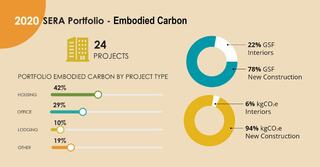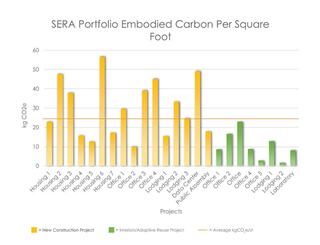Collaborative climate solutions start with carbon benchmarking

The West Coast has experienced an astonishing number of climate-related catastrophes in recent years. Wildfires created widespread devastation and smoke-choked air, atmospheric rivers resulted in extensive flooding, and a heat dome shattered records and resulted in a significant number of deaths.
As architects, we know our work has a significant impact on the climate, and for decades our effort to reduce greenhouse gas (GHG) emissions have focused on energy—analyzing, tracking, finding the best strategies for efficiency, incorporating renewable sources, and sharing these results with our colleagues across the AEC industry.
- How much energy are our buildings projected to use?
- What is the baseline for various project types?
- How far can we push the performance?
By answering these questions and sharing the knowledge, we’ve been able to set benchmarks, collect data, and make great strides as an industry to grow the movement to improve operational energy consumption in the built environment.
Prioritizing Embodied Carbon Impact
As the intensity and impact of the climate crisis have become more obvious and devastating, our efforts to further reduce GHG have ramped up, and we’ve come to recognize that energy use is just one part of picture. Significant quantities GHG are also emitted in the procurement, processing, fabrication, shipping, and construction of buildings. This impact is referred to as “embodied carbon” and tracked as carbon dioxide and equivalent gasses (CO2e).
Because large amounts of greenhouse gasses are emitted over a relatively short time horizon—during the construction process—the immediacy and quantity of the impacts are even more significant than those related to energy use. Climate scientists have pointed out that addressing the short-term time horizon is crucial to minimizing the most destructive impacts of climate change. And as we learned with energy use reporting, knowledge is a prerequisite to making meaningful improvements.

One by one, design firms have begun using life-cycle analysis (LCA) to measure the embodied carbon emissions related to individual projects. Although this is a crucial first step, measuring results of the whole portfolio of work is essential. As an industry, we are still in a nascent phase of the effort. Research and data collection is gearing up, but robust benchmarking doesn’t exist, and even the metrics themselves are evolving. For example, most reporting is based on kilograms and metric tons (tonnes) of CO2e, but because US projects use imperial units (IP), we often end up with a mix of metric and IP units (tonnes per square foot!).
At SERA, we are developing spreadsheet tools and a methodology for calculating and reporting our full portfolio. The painstaking effort, led by Lindsey Naganuma within our Sustainability Resources Group, leverages digital 3D building models to capture the quantities of materials used in a project; converts the quantities using Tally, a tool developed by Kieren Timberlake; and finetunes and supplements the data using spreadsheets generated in-house.

We are finding that the analysis for the core and shell of new buildings is relatively straight-forward, but digging into embodied carbon analysis of adaptive reuse projects and building interiors is extremely complicated. Because a wide range of conditions and assumptions must be accounted for (scope of existing vs. new construction, time horizon, life cycle stages, etc.) a consistent framework for benchmarking all project types is essential.
An Industry-wide Effort
It can take years for tools and resources to evolve through cycles of development, testing, and application. Energy analysis tools and benchmarking ramped up during the 1970s, with significant funding from the US Department of Energy (DOE). Major improvements and widespread adoption have resulted in relatively high literacy of energy use in buildings among professionals. A similar infrastructure of tools and resources is urgently needed for embodied carbon.
Fortunately, a big team effort is coming together. New tools are being developed; new initiatives, like the 2030 Challenge, are focusing on the topic; and new collaborations, like the Carbon Leadership Forum (CLF), are bringing the broader industry up to speed.
In the coming months, we are eager to collaborate with our peer firms and the CLF to share our findings and accelerate the development of benchmarking resources. Already, we’re seeing promising results for major reductions through building reuse, sustainably harvested wood (including mass timber), and dialing low-carbon concrete into the design mix, but the big picture context for understanding the relative benefits will be provided through robust and accurate industry-wide benchmarking.
Processes for Quantifying Embodied Carbon
Analyzing a building’s design for embodied carbon impact is made possible only with the collaboration of a wide range of professionals within the AEC industry. First, SERA uses digital 3D building models to capture the quantities of all materials used in the project. The models are developed by SERA’s architecture and interior design teams, who incorporate models from the project’s structural engineer. Once we have a clean and complete model, SERA’s Sustainability Resources Group (SuRG) uses a tool called Tally to convert the quantities of materials in the 3D model to total mass and embodied carbon impact. The mass and embodied carbon data that Tally references are from GaBi, a lifecycle database and material Environmental Product Declarations (EPD’s), objective reports that are provided by product manufacturers and industry associations. SuRG also uses spreadsheet tools that we’ve developed to supplement the capabilities of Tally when projects have unique elements that require different analysis methods. In some cases, detailed information is provided by the project’s contractor to fine-tune assumptions for transportation distances or construction methods. From manufacturers and software engineers to designers and contractors, analyzing the embodied carbon impact of buildings is truly a team effort!
Co-authored with Lindsey Naganuma


